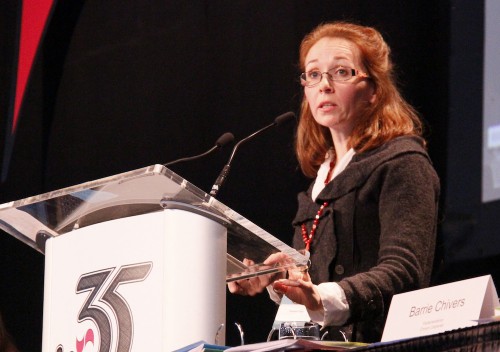UNA members urged to 'push back' against privatization
The best strategy for ensuring fair, universal long-term care in our society is to resist the efforts by Canadian governments to encourage “privatization, commoditization and marketization” of seniors’ care, York University Health Policy Professor Tamara Daly told UNA’s AGM Wednesday afternoon.
“One of the things we can do is push back and say, ‘this is not working for us,’” said Daly, who along with Edmonton health care researcher Diana Gibson addressed delegates on the future on long-term care in Alberta and Canada.
Comparing seniors’ care in Canada unfavourably to the system in place in the Nordic countries, Daly argued to the applause of delegates that care for older adults in this country should be considered “a right of citizenship.”
Among the other strategies for stemming the deterioration of seniors’ care in Canada, an inevitable result of privatization, Daly called for the imposition of legislated minimum care standards as “an absolute necessity.”
Because the majority of seniors in care are women, and the vast majority of their caregivers are women as well, Daly argued that our increasingly privatized and inaccessible system is “a symbol not only of how we treat vulnerable women but of how women’s work is treated in this country.”
Study after study illustrates, Daly said, that costs are higher, care is worse and workplace violence against women is more frequent in for-profit than public health care facilities.
Gibson, the Research Vice-President of PolicyLink Research and Consulting and the former director of the Parkland Institute, called the seniors’ care privatization strategy of the Alberta government an effort to “offload the costs of the public sector onto the backs of seniors.”
“Alberta is continually moving away from health care on the basis of need to the ability to pay,” she complained.
Yet, despite constant propaganda to the contrary, Gibson said, “the private sector doesn’t magically build us (seniors’ care) infrastructure for free. There’s absolutely no reason for them to build infrastructure on this model other than ideology.”
Gibson also noted that one reason private-sector costs are typically higher is that for-profit companies lack the public sector’s ability to buy in bulk. “Bulk purchasing is cheaper. The private sector doesn’t have access to the bulk purchasing discount that the public sector does.”
She agreed with Daly that unbiased research clearly shows “the for-profit model impacts very significantly on the quality of care. Staffing rates are cut in for-profit facilities, and the quality of care goes down.”
With Alberta’s buoyant economy and a fair taxation and royalty system, Gibson concluded, we can afford a fair seniors’ care system regardless of how we choose to pay for it. “The question needs to be, which system delivers the better care, and it’s the public system.”


